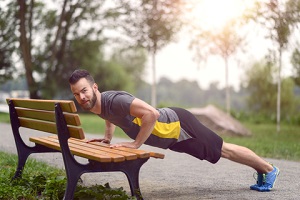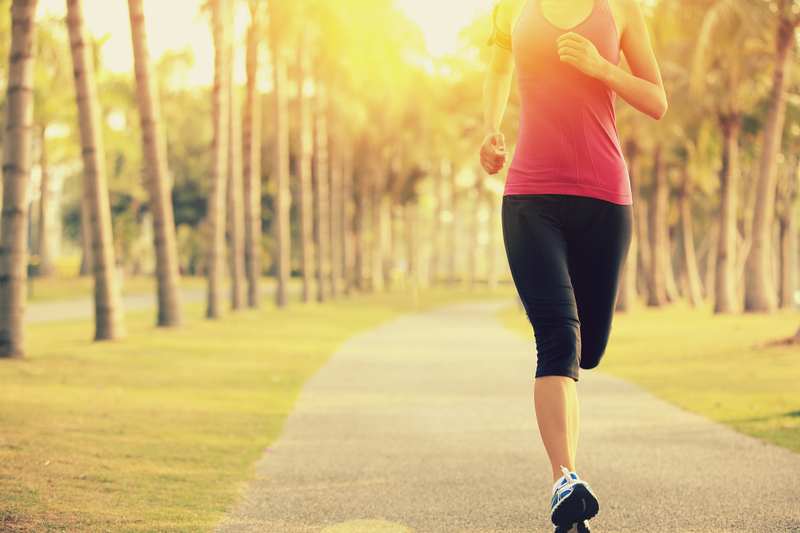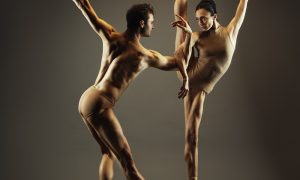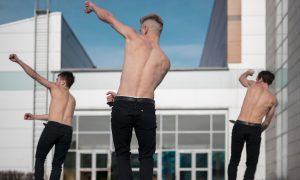We know that cross-training helps dancers dance longer, stronger and with greater grace. Flexibility and coordination aren’t the only thing we need to perform at our best; we also need aerobic capacity, muscular strength (particularly for those who lift other dancers in partnering) and overall stamina. Daily class often isn’t enough to create balanced fitness. Cycling, running or aerobic walking, and strength training are great options for dancers.
It’s spring in the Northern Hemisphere, and why not take that cross-training outside? Moving outside can offer connection to nature and creative insights that exercising indoors can’t. Here’s a sequence that can offer balanced fitness benefits for dancers (and all people) in the great outdoors. Lace up your sneakers, grab your iPod, and enjoy!
#1. Warm-up walk.
This part is typically easy enough, as you’ll need to head to where you’re doing your outdoor workout anyway. Public parks are great options, as they’ll have plenty of space and the structures that you’ll need for the following exercises. As you walk, feel free to warm up your joints with isolations – head rolls, wrist rolls, across-chest tricep stretches. Notice your smooth rhythm of breath, and take in the sights around you.
#2. Hills sprints.
This exercise works stamina (“slow twitch” muscle fibers), speed (“fast twitch” muscle fibers), balance aspects and cardiovascular efficiency. Start by choosing a surface with any amount of incline. Try jogging in place for 10-30 seconds to get your stride and rhythm. Then jog down the incline, turn 180 degrees, and sprint back up. Do five to 10 cycles, until your heart rate is raised. Next time, maybe try for 12-15. We build endurance and strength through gradually challenging our bodies with just a bit more work. That approach also helps avoid feeling defeated and discouraged.
If you don’t have an inclined surface, jog in place 10-30 seconds, and then pick up the pace (kicking your knees up to your lower belly), then back to jogging, and so on for five to 10 cycles. Whichever you do, walk – rather than stop short – when you’re done. That will help prevent muscle cramping and gradually bring down your heart rate. At the same time, keeping your heart rate somewhat elevated the whole time can contribute to cardiovascular endurance, so try not to come to a full stop!
#3. Strength series.
 This series alternates four sets of exercises that strengthen all major muscle groups in the body. Survey your area and find a tree with a branch you can reach (and will support your body weight) and a raised level surface such as a rock or park bench. Start at the tree.
This series alternates four sets of exercises that strengthen all major muscle groups in the body. Survey your area and find a tree with a branch you can reach (and will support your body weight) and a raised level surface such as a rock or park bench. Start at the tree.
Grab the branch and do 1) five to 10 pull-ups (to any degree of lift up; you don’t have to get your chin to the branch to be building strength) and 2) 10-15 knee-ups (lifting your legs to somewhere in between your low belly and chest). Take a quick rest in between if you need to re-adjust your grip on the branch, but again, try not to stop short!
Then head to your park bench or other flat, raised surface. Place your hands flat on it, and lean in slightly, that so your body forms a flat plank. Do 3) five to 10 “incline” push-ups, doing your best to keep your body in a straight line throughout and your elbows tucking right back into your body as you lean into the structure you’re using. Then step up unto the structure and raise one leg to hip level. You can place hands on hips or reach them up, palms facing into one another and triceps forward (making a number “11” around your head). Next, 4) bend and extend your raised leg 10-15 times, and the same with the standing leg (with the raised leg at hip-height, so that your legs form an L). Then 5) hold and balance for 30 seconds, thinking about length everywhere in your body. Do both of those on your other leg. You can get creative with other variations, if you’d like – pulses, twists, relevés/elevés, other balances and bends.
Just ensure that you’re aligning your joints – hips, knees and ankles in particular. Those areas are vulnerable to injury, especially in very flexible people. Speaking of potential injury, if anything feels particularly unstable, like you might fall, remember that getting injured and missing training and performance isn’t worth something that might make your workout just slightly more effective.
Then step off the structure to a relatively level area (watch out for little ditches and other areas that could be dangerous – such as in your ankle folding to one side). Squat in a deep parallel second position, and then 6) push off the ground to jump up. Land back in that second position, making sure to absorb the shock with that deep bend. Align your knees over your toes for safety of your joints (just as in a ballet barre). Do 10-15 jumps. Have your arms move with the jumps in a way that feels natural, fluid and keeps your body’s momentum going.
One round of those six exercises might be enough. You might have it in you for another round, and your mind, body and spirit might want that. So go for it! Maybe next time you’re feeling up for three rounds. Listen to your body, drink water when you need it and be honest about what’s best for you today. At the same time, don’t be afraid to challenge yourself. With a dose of can-do attitude and the joyous energy that being outdoors can offer, you might surprise yourself with what you can accomplish!
#4. Freestyle cool down.
Now’s a time to ground and cool down from all of that good work. Come to sit, or lie on your back, and focus back on breath for a moment. Maybe close your eyes, if that’s comfortable to you, and turn your attention toward anything notable that you’re feeling inside. When you’re ready, take some core exercises that you know and like (standard crunches, oblique work, Pilates exercises).
Then take a good stretch series, incorporating arms, shoulder girdle, torso (including the side bodies), hamstrings, quadriceps and glutes. Take a couple of twists that you like, from yoga or otherwise, to finish off the detoxifying effect that exercise can offer. Meanwhile, key into sights, sounds and smells that you perceive. Try to stay in your present experience, yet notice any creative thoughts or impulses that might be emerging.
One or more of these could even lead to a movement phrase or larger choreographic concept, or simply sharpen your artistic sense as a dancer. Finish with a last moment of keying into your breath and enjoying the effects of your whole-body, whole-person exercise. Perhaps offer a thought of gratitude for the gift of what your body can do. Something you’ve gained, or are simply experiencing right now, could be something that can enhance the rest of your day (or beyond) – simply by you bringing that forth from right here, right now.
By Kathryn Boland of Dance Informa.















